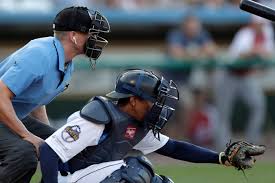First Robo Cop Now Robo Ump?!
Major League Baseball is bringing the future to the sport a little earlier than expected.
The television seen is the “robotic umpire” that uses Doppler Radar technology to communicate balls and strikes to the human umpire below on the field
Baseball, since the invention of the radio and television, has been America’s past-time. A few decades ago people would come home from work or school, take a seat on the couch, turn on the TV or radio, and watch baseball.
Between lower ticket sales and a lack of new viewers, it appears as if the excitement of the game has been lost for the newer generation of baseball fans. For that reason, the front office executives of Major League Baseball decided that it was time for some changes.
The biggest problem with all of these changes is that it would not make much sense to just implement them into the “Big Leagues” without testing them first. The solution, send them to the Minor Leagues, a bridge between college and the pros where new rules and adjustments have been tested for years.
This season, the most bizarre addition is that of the robot umpire, which debuted at PeoplesBank Park, home of the York Revolution.
The Revolution are a part of the Atlantic League which is a division of Minor League baseball that includes teams from Long Island, N.Y., Texas, New Jersey, as well as Lancaster, Pa.
According to an article in The York Dispatch, there is a “three-year partnership between the MLB and the Atlantic League, which tests experimental playing rules and equipment initiatives throughout the Atlantic League season. It is being used as a testing ground this year for new rule changes designed to speed the game up a little bit in order to attract new viewer engagement especially from those under 30.”
They started with a few rules being implemented in the first half of the season and more added on after the all-star break in July.
“Changes from first half include: No mound visits from coaches other than for a pitching change or an injury; pitchers must face a minimum of three batters or reach the end of an inning before they can exit the game, unless the pitcher becomes injured; increasing the size of the bases from 15 inches square to 18 inches square; the time between innings and time allowed for pitching changes is reduced.” (York Dispatch)
Most of these new changes seem unimportant and probably have little to no chance of making it to the MLB. While this is true, one change caught the attention of the media. And it just happened to take place in York, PA, making the York Revolution a national story.

Umpire Brian deBrauwere is seen with with his earpiece in that connects him to the ABS System that is watching from above.
On July 10, the news teams rolled in for the annual All-Star game, this year being held at PeoplesBank Park. This was not for a player or a coach, but rather a robot. More specifically, an Automated Ball-Strike System (ABS). Also known as a robotic umpire.
The ABS System uses Doppler Radar technology to call balls and strikes during the game. Doppler is also the same system that is used for the weather.
“This is a landmark day for the Atlantic League and professional baseball,” said Atlantic League President Rick White in a news release. “After successfully unveiling the ABS at our All-Star Game in York, Pa., and following positive feedback from managers, players, umpires and fans, we are eager to implement the consistent strike zone accuracy offered by ABS technology.”
Someday in the near future, viewers could possibly tune in to see robot umpires in MLB, and it may have all started in our backyard.
Your donation will support the student journalists of Dallastown Area High School. Your contribution will allow us to purchase equipment and cover our annual website hosting costs.